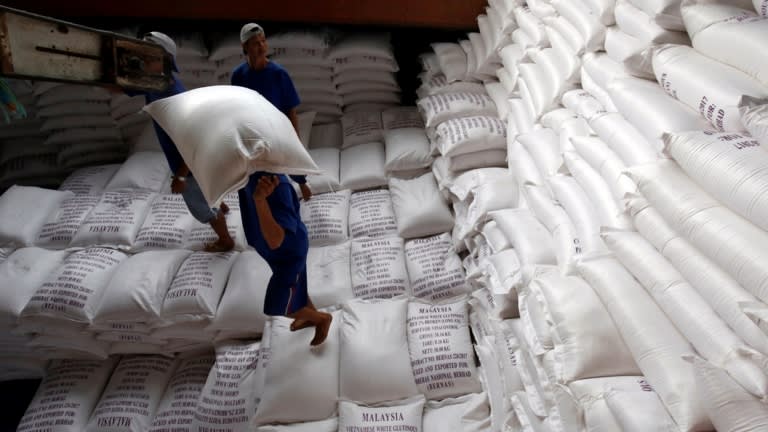The World Trade Organization made clear the economic calamity of the coronavirus pandemic this week, predicting that global trade could plunge by as much as a third over the next three years. Yet even this dire scenario may turn out to be optimistic if, as seems likely, a new wave of protectionism follows in the virus's wake, including here in Asia, risking a repeat of the avoidable policy mistakes that led the 1929 Wall Street Crash to slide into the Great Depression.
In times of crisis the urge to protect your own is strong, as shown by the ongoing global race to curb exports of medical equipment. The starkest example came when German bureaucrats recently accused the U.S. of "modern piracy" for allegedly intercepting surgical masks in Thailand. But 54 nations have introduced export limits on medical supplies this year, most of them since March, according to Global Trade Alert. More will follow.
Food is set to be next. Major producers of wheat like Kazakhstan and Russia are already limiting supplies. In Asia, both Cambodia and Vietnam have introduced rice controls. Producers of staples like corn and soybeans will do likewise, just as they did in 2008, jacking up global prices.
Restrictions are unlikely to stop there. Previous slumps hit particular industries or countries harder than others. This one is global, in the sense that almost no sector will be spared. Calls for tariff protection from politically connected industries are inevitable, from steel-makers hit by falling construction demand to electronics makers claiming competitors abroad get unfair state support. Much the same is true for non-tariff barriers like import quotas or embargoes, which have risen steadily since 2008.

Men load rice bags to a ship for export at a rice processing factory in Vietnam's southern Mekong delta: the country has introduced rice controls. Photo: Reuters
The global financial crisis shows how hard it is to stop a wave of beggar thy neighbor protectionism, in which policies promoting growth in one country harm it in another, typically prompting retaliation. International Monetary Fund managing director Kristalina Georgieva recently described our current economic moment as "way worse" than 2008. Given this, we should expect the subsequent wave of protectionism to be worse too.
None of this is helped by the way in which U.S. President Donald Trump has normalized tariffs as means of international score-settling. India on April 5 banned exports of hydroxychloroquine, for instance, an anti-malaria treatment that Trump suggested, with scant evidence, could help to treat COVID-19. In a taste of coronavirus diplomacy to come, the U.S. quickly threatened retaliatory tariffs of its own -- forcing a rapid climbdown from Prime Minister Narendra Modi's government.
Salutary lessons are clear from the 1930s. As economists like Barry Eichengreen have shown, a wave of tit-for-tat tariffs began in the U.S., leading to reciprocal measures in Europe and elsewhere. Over the next few years, nations that remained on the gold standard also used trade measures to counter others who had been able to devalue their currencies.
The result was what Eichengreen and co-author Douglas A. Irwin call "a severe blow to world commerce," with trade falling by a quarter in three years, half of which was due to protectionism.
The precise pattern of our own protectionist surge is hard to foresee, but we can know one thing for sure: it will have long-term consequences. Crisis measures have a habit of sticking around. To take one example, income tax in the U.K. was first introduced as a supposedly temporary measure in 1799, during the Napoleonic Wars.
In much the same way, U.S. sugar prices remain high today as a legacy of quotas introduced in 1934, which were never overturned because of domestic lobbying.
Amid all this, some amount of protectionism is inevitable and understandable, as nations reassess which goods need to be kept and produced at home. French President Emmanuel Macron said at the end of March that he wanted his country to be self-sufficient in crucial medical equipment in one year. "The priority today is to produce more in Europe and France," he said.
But the losers will still be trade-dependent economies on the one hand and developing nations on the other, including here in Asia. Poorer nations will be hit in areas like medicine in particular, where suppliers are concentrated. Just three countries, China, Germany and the U.S., export 40% of the world's medical personal protective equipment. A few restrictions in a handful of major exporting nations could therefore hit many others, just when they need supplies most.
There is still plenty which policymakers can do to stave off the worst of this future. Coordinated tariff reductions might be too much to hope for, but it is at least worth noting that restrictions on many critical medical goods are already high, not least hand soap, which faces a global average tariff of 17%, according to the World Trade Organization.
Even if lowering restrictions is too hard, commitments simply to avoid new increases would help, as the G-20 large economy nations agreed to do in the aftermath of the 2008 crisis. Regional bodies like ASEAN or APEC also have a role to play in limiting excessive restrictions in Asia. And if not that, then ad hoc groups might help too, as with the six-nation grouping that in late March pledged to protect global supply chains, including Australia, Canada, New Zealand and Singapore.
Even so, the odds of a wave of protectionism being avoided are slim. In the aftermath of 2008 some commentators predicted the arrival of a new era of mercantilism. The coronavirus crisis of 2020 makes this more likely than ever.
This article was first published in Nikkei Asian Review on 9 April 2020.
A child washes hands with anti-bacterial soap in Dhaka on Mar. 27: hand soap faces a global average tariff of 17%. Photo: LightRocket/Getty Images